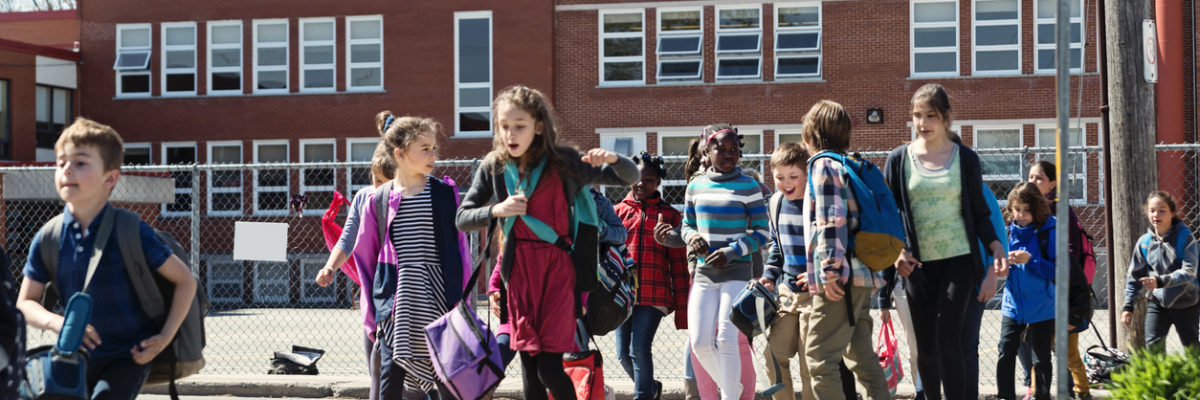Students, influenced by Greta Thunberg, are participating in unprecedented global-wide protests. On September 27, 2019, building on Fridays for the Future, thousands of school-age children are expected to demonstrate for urgent action on climate in Ontario. Young people are dismayed by the lack of action on the part of governments and others on the most critical challenge facing civilization.
That means school boards, which have numerous buildings and physical plants that contribute to carbon emissions, can be an important actor in mitigating climate damage. The recently created Joint Management Labour Environment Committee (JMLEC) at the Toronto District School Board (TDSB) is made of up representatives from management and labour and works to reduce the carbon emissions emitted by the 584 buildings of Canada’s largest school board. The committee urges the TDSB to add “sustainability” to the mission statement, in addition to equity, well-being and achievement.
School boards in Ontario are facing financial challenges including aging buildings in need of repairs and upgrades, high utility costs, and a limited budget for repair and maintenance. Investing in energy efficient retrofits, repairs, preventative maintenance, and greener transportation will reduce operating costs and put the savings back into energy retrofits, and other areas.
Urgent actions proposed
Very practical as solutions to cost-savings and sustainability have been proposed. Here are five ideas:
- SWITCH TO LED LIGHTING
Many school buildings have outdated lighting that is energy inefficient and costly to operate. A switch to LED will save thousands of dollars annually in electricity costs, reducing carbon emissions and cutting down on hazardous materials, which are found in other bulbs. LED is also better lighting, providing a healthier learning environment. At Toronto’s Pearson Airport switching to LED bulbs and fixtures in the Terminal 3 garage back in 2013 saves the GTAA $200,000 annually.
- UPGRADE AND MAINTAIN HVAC SYSTEMS
Most of a school board’s carbon emissions come from the natural gas used to heat and cool buildings, and to a lesser extent, electricity. Retro-commissioning mechanical systems will reduce emissions, starting with those building with the highest energy intensity. Upgrading the HVAC systems in school buildings and installing building automated systems (BAS) that use computers to control building temperatures and the operation of mechanical equipment will lead to greater improvements and cost savings. For maximum performance, HVAC systems must be monitored, allowing a shift from reactive to preventative maintenance practices.
- GREENING THE FLEET
Most major automobile manufacturers are on a trajectory to phase out internal combustion engines (ICE). Converting the school board’s fleet to non-ICE vehicles as mass production electric vehicles become available is an opportunity to demonstrate climate leadership and reduce operating costs. Better route management will also help to reduce emissions. As an example, Toronto Hydro managed to reduce its fleet-related emissions 28% between 2013 and 2016, mainly by reducing the number of vehicles, optimizing their use, and reducing idling. Toronto Pearson has also invested heavily in electric vehicles and chargers to help reduce their emissions.
- REPLACE WINDOWS AND DOORS
Many of the buildings were originally constructed to maximize airflow and ventilation. Renovations over time have resulted in blocking that flow, forcing school boards to invest in expensive cooling systems. Reopening the transoms over interior doors is a simple and inexpensive way to create better ventilation in schools, thus again saving costs and emissions.
- CONTINOUS IMPROVEMENT
Conducting regular business process analysis will identify ongoing opportunities for retrofits of obsolete and inefficient mechanical systems and lead to a coordinated approach to replacing those components and systems.
Overcoming challenges to reducing carbon
It must be recognized that all the changes recommended require investment, and management tends to operate from the perspective of short-term cost reduction rather than planning for long-term savings. In addition, it often easier to continue using familiar technology rather than changing to using new systems. Changing to new systems, technologies, software and hardware may not only involve the cost of the new equipment but also training people to use them. They key is to focus on the lifecycle costs and benefits, including for the health of the people involved and the planet.
Collaborative approach to carbon reduction in Ontario’s school boards
In 2018, TAF provided funding to the Labour Education Centre to support development of a JMLEC at the TDSB. JMLEC has equal representation from management and labour and a mandate to reduce carbon emissions at the board. The committee has worked successfully to find solutions and remove some of the barriers. Their work includes meeting with the board’s facilities department to review the Energy Conservation and Demand Management Plan and developing the recommendations listed above to help facilities managers reduce GHGs. Bringing the partners together to develop shared agendas has been an effective strategy.
Some ways to get climate action at your schools
- Ask your board to form a joint committee with a mandate to reduce carbon emissions
- Ask to see the Energy Conservation and Demand Management Report and review for achievements
- Ask to review the school board’s plan to achieve energy conservation and reduce carbon emissions
- Meet with your school trustee to ask for a focus on the combination of sustainability and savings
For more information, contact the Labour Education Centre.

